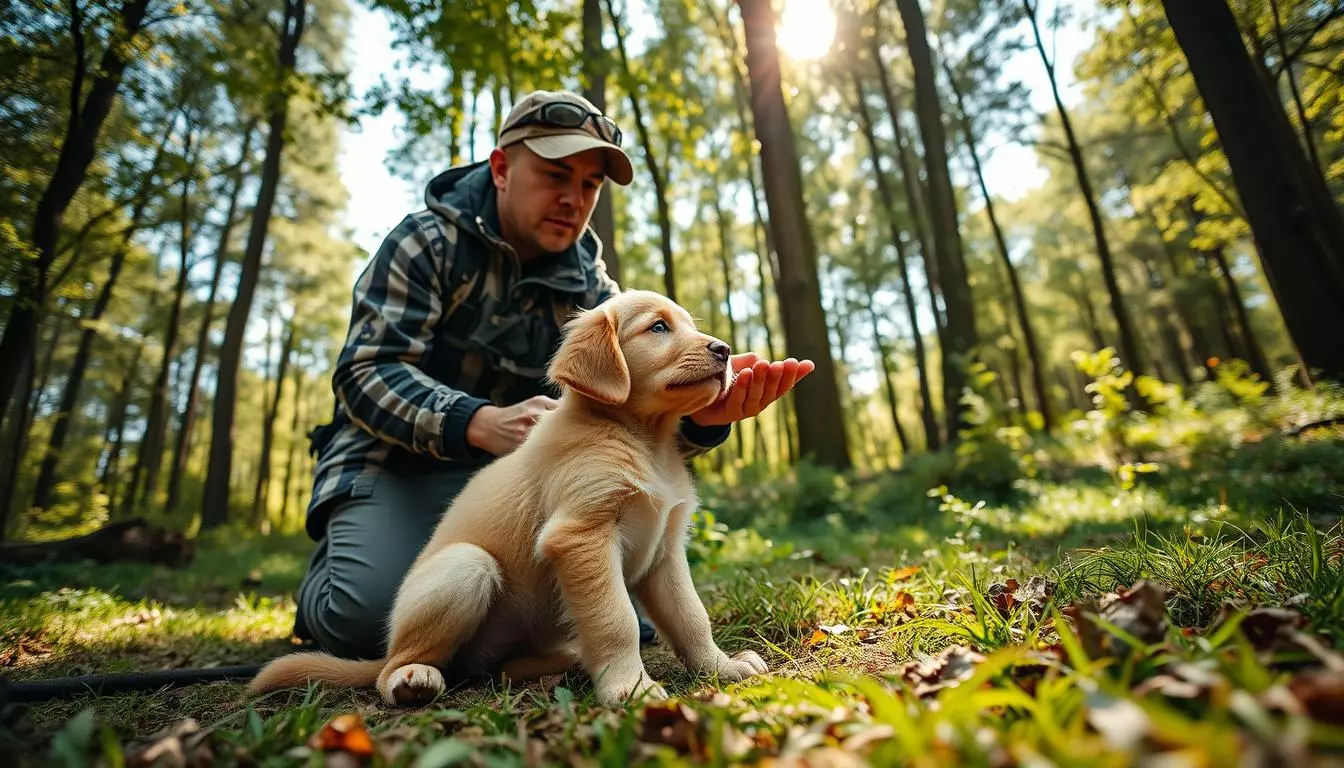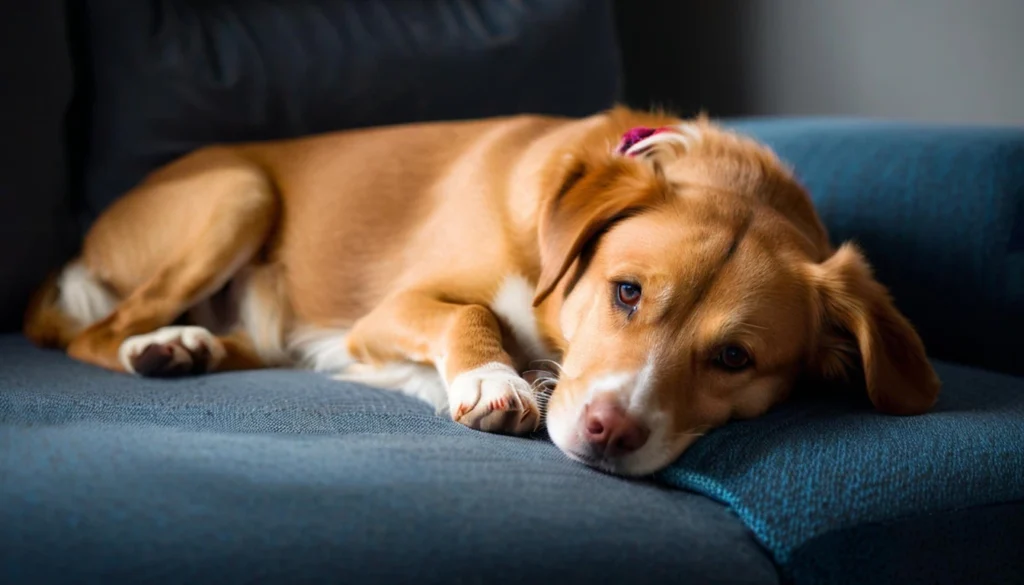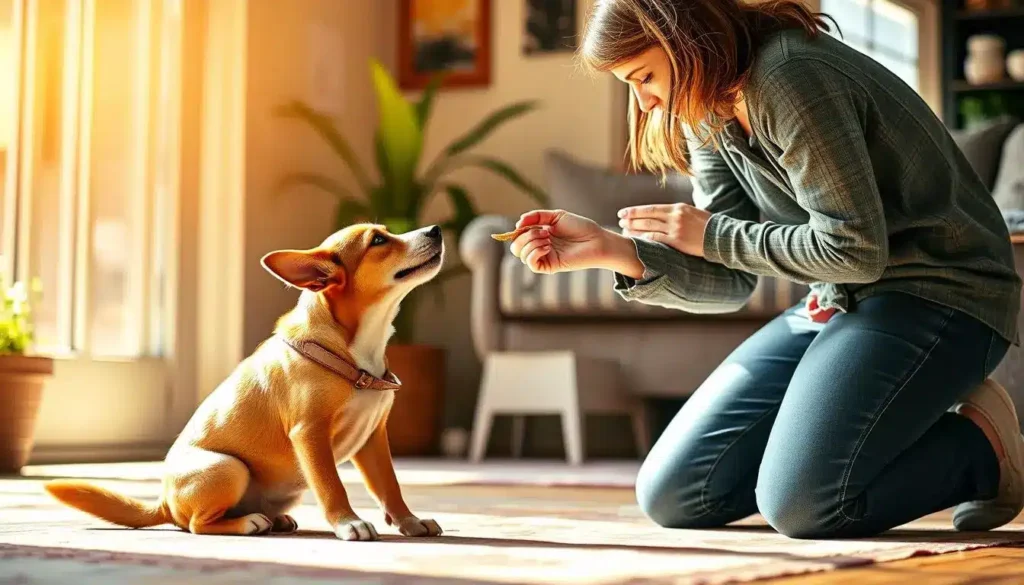I've always loved spending time outdoors with my dogs. Together, we've made many memories while hunting. The bond between a hunter and their dog is unique, based on trust and teamwork.
But, building this special connection takes time and effort. It starts with knowing how to train a hunting dog well. This journey is both rewarding and challenging, especially for beginners.
In this article, I'll share my best tips for training hunting dogs. These strategies will help your dog reach their full potential in hunting.
Key Takeaways
- Training a hunting dog is essential for safety and hunting success.
- Understanding a dog’s instinct plays a critical role in effective hunting dog training.
- Choosing the right breed can impact training ease and effectiveness.
- Starting at the right age is crucial for developing skills.
- Consistency and positive reinforcement help in building obedience.
- Gradual exposure to hunting scenarios enhances readiness.
- Regular training schedules ensure skills remain sharp.
Understanding the Importance of Training a Hunting Dog
Training a hunting dog is crucial for both the hunter and the dog. It makes hunting better and strengthens our bond. Dogs learn important commands like sit, stay, and come. These are key in hunting.
A trained dog knows how to find and bring back game well. This helps me hunt better and keeps everyone safe. Spending time on training makes hunting more fun and successful.
Choosing the Right Breed for Hunting
Choosing the right dog for hunting can be tough. There are many breeds, each with its own traits. Labrador Retrievers, German Shorthaired Pointers, and Beagles are top picks. They have great senses and adapt well.
It's important to think about the type of game you'll hunt. For waterfowl, a retriever is best. But for upland game, pointing dogs are better. Knowing what each breed is good at helps match them to your hunting style.
Researching breeds is key to a good hunting experience. Look at their strengths and weaknesses. The right dog will make your hunts better and create a strong bond.
What Age to Start Training a Hunting Dog
Figuring out when to start training a hunting dog is key. Most experts say to begin around 8 weeks old. At this age, puppies soak up new things like a sponge. Knowing the puppy developmental stages helps make the most of their learning.
Developmental Stages of Puppies
Puppies go through many stages that affect their training. In the first weeks, their brains are super open to learning. This is the perfect time to introduce them to new places, sounds, and smells. It helps build their confidence and sets a strong base for future training.
Socializing Young Dogs
Socializing is also crucial. It shapes their behavior as they grow. Meeting other dogs and people early on helps avoid bad habits later. So, knowing when to start training is linked to helping them get along well with others. With regular exposure, my dogs have done great, showing how vital this stage is for age for hunting dog training.
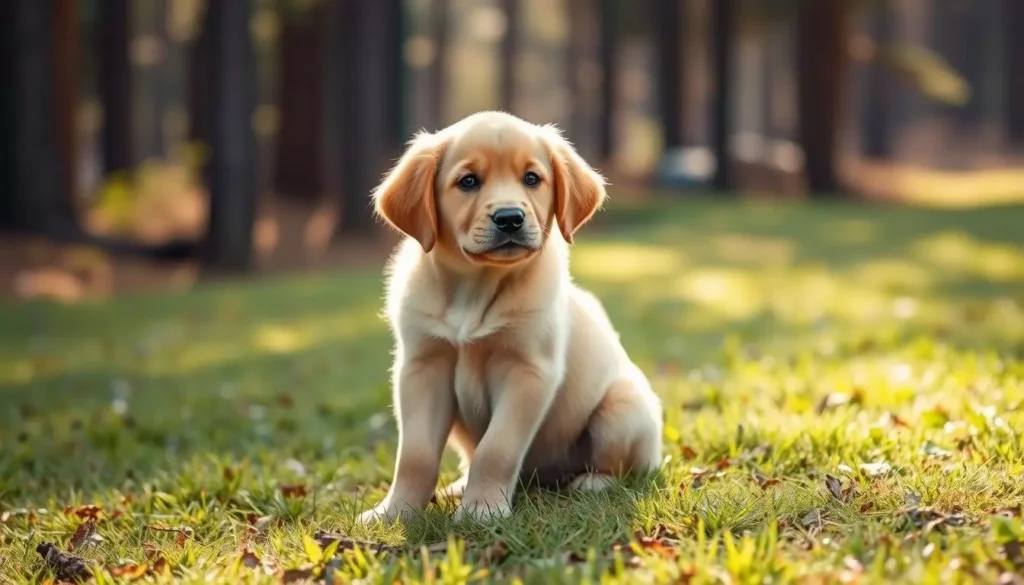
How to Start Training a Hunting Dog
Starting to train a hunting dog means building a strong base with simple commands and routines. It's key to be consistent with the training steps for hunting dogs. This way, your dog knows what's expected.
Make obedience drills a part of your daily routine. Spend at least 15-20 minutes on these exercises each day. This time helps solidify the basic training your dog needs to succeed.
Pay attention to your dog's strengths and areas for improvement during training. Tailor your sessions to meet these needs, balancing challenges with successes. Positive reinforcement is key. Use treats, praise, or playtime as rewards for small achievements. This keeps your dog excited and eager to learn more.
Teaching your dog basic commands like "sit," "stay," and "come" is crucial. Every dog learns at their own speed. Be patient and create a positive learning space. This will strengthen your bond and make training more enjoyable for both of you.
Basic Obedience Training Techniques
Training a hunting dog starts with basic obedience. It's not just about commands; it's about communication and bonding. Respect is key, making sure my dog understands and follows commands without question.
Establishing Command Respect
Consistency is the first step in teaching respect. Clear voice commands and hand signals work well. Dogs learn to associate these cues with actions. It's important for them to know following commands is essential.
Being firm yet gentle helps build trust. This strengthens the bond between me and my dog.
Using Positive Reinforcement
Positive reinforcement is a powerful tool in training. It rewards good behavior with treats or praise. A simple "good boy" or treat can make a big difference.
This approach motivates my dog and makes training fun. It helps them remember commands better and strengthens our bond.
Getting Your Dog Used to Gunshots
Teaching your dog to handle gunshots is key in dog gun training. Dogs that jump at loud noises can be risky during hunting. A step-by-step plan with positive feedback helps your dog feel safe around guns.
Gradual Exposure to Loud Sounds
Start by playing gun sounds softly and reward your dog for staying calm. As they get used to it, increase the volume and get closer. This way, your dog learns to associate gun sounds with good things, not fear.
Simulating Hunting Scenarios
Adding real-life hunting experiences to training is helpful. I use bumpers to mimic hunting while adding gun sounds. By starting far away and getting closer, your dog learns to stay calm during hunts. This method makes them ready for real hunting situations.
Incorporating Advanced Dog Training
Once your dog knows basic commands, it's time for advanced training. This stage sharpens skills like tracking, scent work, and retrieving. Using the right methods can really improve a dog's hunting skills.
Tools like e-collars can help strengthen commands. These advanced techniques build on what they already know. They also get ready for the challenges of real hunting.
Training in real hunting scenarios boosts their instincts. It also makes sure they remember what they've learned. Keeping them challenged keeps their minds sharp and ready for anything.
Here's a look at different training areas and their benefits:
| Training Components | Benefits | Best Practices |
|---|---|---|
| Tracking | Enhances scent recognition | Work on varied terrains |
| Scent Work | Improves focus and determination | Use specific scents for practice |
| Retrieving | Builds physical and mental stamina | Start with short distances, then increase |
Teaching Your Dog to Locate Game
Teaching my dog to find game is key for a great hunting trip. I use special training to boost their skills. Two great ways are quartering drills and using bumpers.
Implementing Quartering Drills
Quartering drills teach my dog to zigzag while searching for game. This helps them cover more area and find scents better. I keep the sessions fun to keep my dog excited about finding game.
Utilizing Bumpers for Reinforcement
Bumpers help my dog learn to retrieve. They make it clear that fetching is what they should do when they find game. This makes them more confident and skilled. Regular practice is crucial for better hunting and more fun in the field.
Training Your Dog to Retrieve Game
Teaching your dog to retrieve game is key to good hunting. It builds a strong bond between you and your dog. It also prepares them for different hunting conditions.
Using decoys and markers makes training fun and effective. This way, your dog learns what to do during a hunt.
Simulating Real Hunting Conditions
To get your dog better at retrieving, mimic real hunting. Set up scenarios that feel like a real hunt. This lets your dog practice under pressure.
It helps them use their instincts and stay focused. By adding landmarks, cover, and scents, your dog learns to move through the environment well. This training gets them ready for the surprises of a real hunt.
The Importance of Blind Retrieve Training
Blind retrieve training is crucial for hunting dogs. It teaches them to find and bring back game they can't see. Using hand signals and whistles helps guide them.
Regular practice improves their skills and focus. A dog that can do blind retrieves will do great in field trials and real hunts. They show their loyalty and dependability.
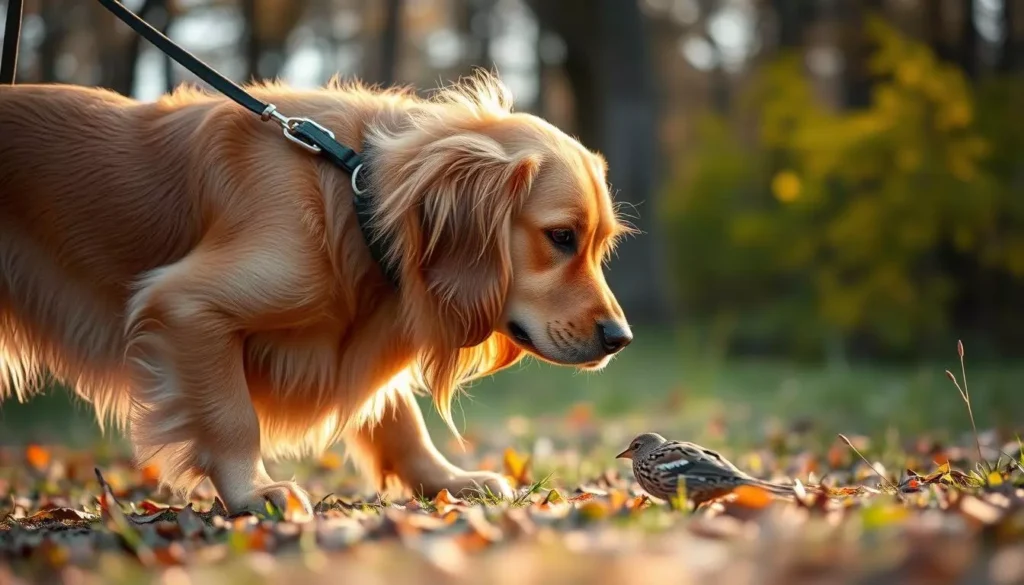
Preparing for the Field: Essential Gear for Your Dog
According to canine sports medicine experts at Texas A&M (Texas A&M Veterinary Medicine's guide to working dog conditioning), proper conditioning and protective gear can prevent up to 60% of field-related injuries in working dogs. Their research recommends gradually increasing physical activity over 6-8 weeks before hunting season, with special attention to paw protection and joint support. The guidelines also emphasize the importance of cooling vests for warm weather hunts and properly fitted harnesses that don't restrict movement during intense activity.
When you're getting ready for a hunting trip, your dog's safety and comfort are key. Good hunting dog gear makes a big difference. A bright orange vest is crucial. It makes your dog easy to see and helps other hunters know who they are.
Don't forget a first-aid kit. It should have bandages, antiseptic wipes, and any meds your dog needs. Also, bring food and water to keep your dog energized and hydrated.
For different hunting places, you might need special gear. A buoyant vest is great for waterfowl hunting. It keeps your dog safe in the water. A strong crate is also important. It keeps your dog safe while traveling and provides a cozy spot in new places.
With the right gear, your dog stays safe and happy. This lets you both enjoy your time in the field more.
Socialization with Other Dogs and People
Socializing hunting dogs is key to raising well-rounded pets. Early interactions with different dogs and people boost their adaptability and confidence. Activities like playdates or dog park visits are great for training and teaching social skills.
My dog's obedience classes were a big help. They not only interact with other dogs but also get used to various people. This is especially important for hunting, where they need to be comfortable in different situations.
Exposure to Various Environments and Situations
It's important to expose your dog to different environments for hunting dogs. This helps them get used to different situations and builds their confidence. A good mix of experiences prepares them for the real hunting world, where anything can happen.
Water Work and Swimming
Water training is key for dogs that will hunt in water. Getting them used to water early on is crucial. It makes sure they're comfortable and good at swimming.
When I train my dog in water, I use positive methods. I want them to love the water, not just tolerate it.
Familiarizing with Open Fields and Cover
Training in open fields and dense cover is essential. It lets dogs explore and use their hunting instincts. This training helps them track better and get used to hunting sounds and smells.
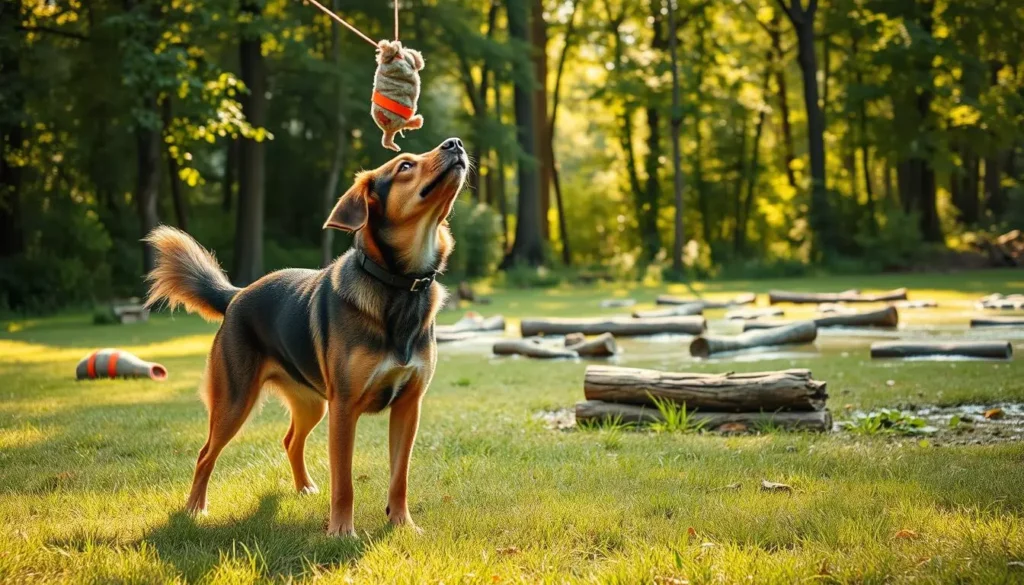
Testing Hunting Skills Through Trials and Tests
Engaging in hunting tests for dogs is a great way to see how well they do in a competitive setting. Events like AKC Retriever Field Trials let my dog show off their skills in real hunting-like conditions. Each trial is a chance to see how my dog is doing and where they need to improve.
These trials help me figure out what my dog is good at and what they need to work on. Because they're structured, it's easier for me to plan how to improve their skills. They test everything from retrieving to following commands, making sure my dog is ready for hunting.
Being part of these events does more than just test my dog's skills. It strengthens our bond and makes us a better team. Seeing my dog in action makes me proud of all the hard work we've put in. It also gets me excited for what we can achieve together in the future.
Pack Proper Hunting Supplies for Safety
When I get ready for a hunting trip, it's important to pack the right stuff. This ensures my safety and my dog's well-being. A first-aid kit is at the top of my list. It helps with any small injuries we might face in the field.
Staying hydrated is key, especially on long hunting days. I bring portable water bowls and special hydration packs for dogs. I also pack nutritious food to keep my dog's energy up.
A travel crate is great for giving my dog a safe place to rest or travel. I also use dog safety gear like reflective vests or harnesses. These make us more visible and secure in new places. I also bring engaging toys or treats to keep my dog happy and focused when we're not hunting.
Being prepared with these safety items makes our hunting trips better. It lets me enjoy the hunt more, knowing my dog is safe and happy.
Creating a Regular Training Schedule
Setting up a training schedule for hunting dogs is key to success. I make sure to set aside specific times each week for obedience and skill training. This consistency helps my dog learn and grow.
Varying activities keeps my dog engaged and prevents boredom. I switch between obedience drills, retrieving, and scent work. This keeps things interesting and helps my dog develop all skills.
I keep an eye on my dog's progress and adjust the schedule as needed. This ensures the training stays effective and meets my dog's needs. The goal is to always improve, and a flexible routine helps achieve that.
| Training Activity | Frequency | Duration | Notes |
|---|---|---|---|
| Obedience Training | 3 times a week | 30 minutes | Focus on basic commands |
| Retrieving Exercises | 2 times a week | 45 minutes | Include blind retrieves |
| Scent Work | 1 time a week | 30 minutes | Introduce new scents regularly |
| Socialization | Daily | 15 minutes | Interacting with other dogs |
Conclusion
Training a hunting dog is more than just teaching commands. It's a journey that includes basic obedience, specialized skills, and socialization. Each step builds on the last, making my dog confident and capable in the field.
Looking back, patience, consistency, and dedication are key. The bond we form makes training better and strengthens our relationship. Every moment together prepares us for future adventures.
As I keep training, I focus on enjoying small victories and the time with my dog. The right approach makes training a journey filled with memories, not just a goal.

